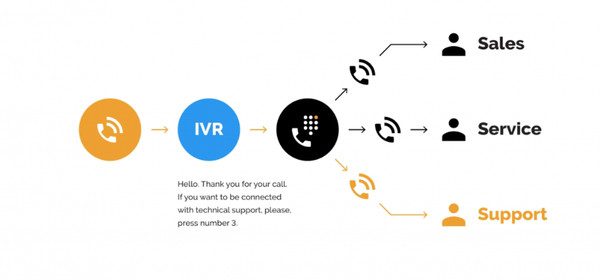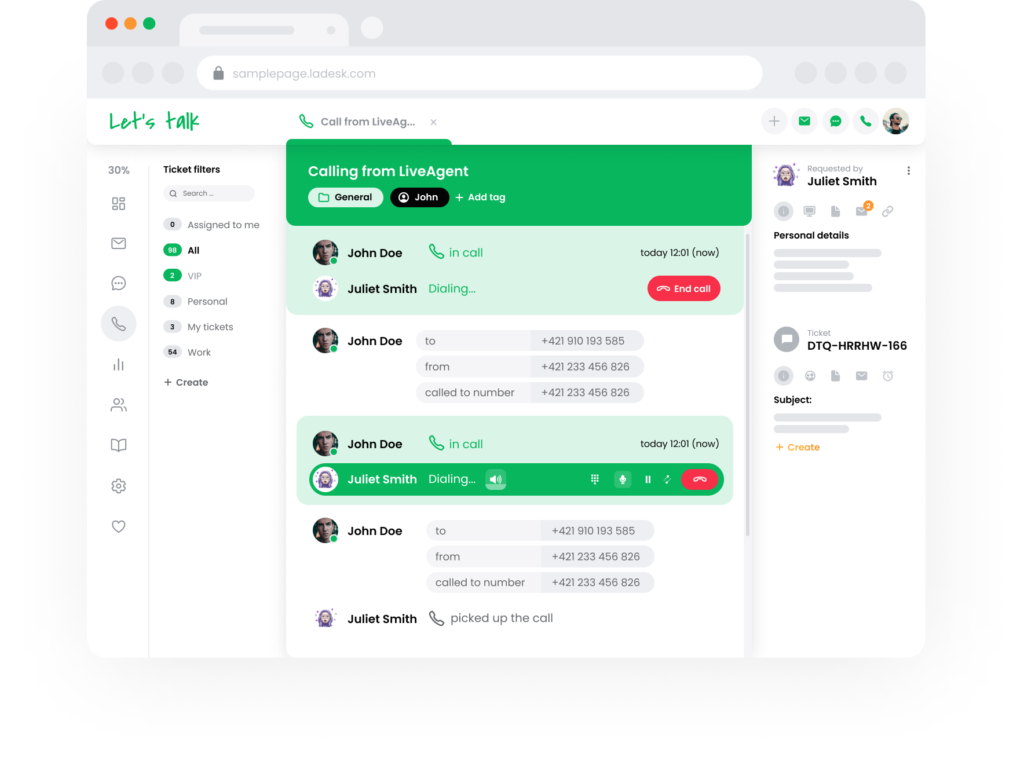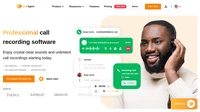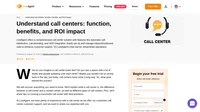What is echo cancellation?
Echo cancellation is used in telecom and telephony applications to improve the quality of voice communication. It prevents echos from being created or captured. It can also remove the echo in post-processing. Echo cancellers operate by first analyzing the incoming voice stream and simultaneously monitoring the return voice stream before it’s being transmitted. If the echo is detected, the echo cancellation engine subtracts it from the transmitted or received audio signal.
Echo is typically created either when a microphone picks up the voice from the speaker and broadcasts it back to them (this is referred to as acoustic echo), or when electrical signals encounter an impedance mismatch in the telephone network (this is known as line echo). Thus, echo cancellers can be classified into two types: acoustic echo cancellers (AEC) and line echo cancellers (LEC).
An adaptive filter is a vital component of acoustic echo cancellation systems. The basic principle of adaptive echo cancellation algorithm is to simulate the echo path, generate a replica of the echo, and then subtract it from the received voice signal.
When is acoustic echo cancellation required?
Acoustic echo usually occurs when the speaker volume is very high, when the microphone and the speaker are in very close proximity to one another, or when a highly sensitive microphone is used. While an echo with a delay of less than 40ms is not likely to be perceived by a human ear, anything over 40ms starts to become noticeable and it might sound irritating to the listener.
In the call center environment, acoustic echo can stand in the way of efficient customer communication. Not only is it annoying to both sides of the interaction (call center agents and customers), it can result in misunderstandings and important information being missed. That can ultimately decrease the overall customer experience as well as call center performance. This is why acoustic echo cancellation and removing noise from calls are essential to ensuring efficient interactions in call centers.

Echo cancellation is also required in Interactive Voice Response (IVR) systems that employ automatic speech recognition (ASR). It helps prevent an echo from the prompt being played to the caller. It also improves the accuracy of speech analytics.
How can I prevent my video calls and microphone from echoing?
Whether it’s customer support calls or conference calls with co-workers, dealing with acoustic echo and background noise can be a challenge. Here are some of the basic steps you can take to prevent echoing during voice and video calls.
Wear headphones
One of the fastest and easiest ways to eliminate echoing is by simply using headphones. Since there is no sound coming out of the speakers (as the speakers are in your ears), the microphone is not likely to pick it up which avoids echoing. That can be applied to both one-to-one video calls and group conference calls.

Adjust your volume level
When your speaker volume is too high, your microphone can pick up the voices of other call attendees causing an echo that you might not even be aware of. Turning down the volume and properly adjusting your microphone sensitivity settings ensures your microphone will only pick up your own speech.
Enable half duplex communication
Another quick way to eliminate echoing is by using half duplex communication, where only one speaker’s audio is transmitted at a time. That means having all the participants of a call mute themselves when they are not speaking. The downside of this approach is that the call could not feel like a natural, uninterrupted conversation.
Set up your call center
Discover more benefits of LiveAgent's robust call center software.
Watch a video about echo cancellation
Echo cancellation is an algorithm used to remove echo from sound systems in order to improve sound quality during calls. Echo cancellation uses sound waves to determine the location and size of echoes which it then eliminates to reduce reverberation and enhance sound clarity. LiveAgent is a help desk software that helps organizations maintain effective communication with customers. It offers features such as interactive voice response, live chat, and ticketing systems to enable a comprehensive customer service experience. By leveraging echo cancellation and LiveAgent, organizations can provide a better customer support experience.

Frequently Asked Questions
What is echo cancellation?
Echo cancellation technology is used in telephony to remove echo and other unwanted white noise. It helps with speech enhancement and audio clarity on both ends of the line. It operates by monitoring the incoming and outgoing audio stream and subtracting the echo from the transmitted or received signal once it’s detected. Echo cancellers are commonly classified into acoustic and line echo cancellers.
When is acoustic echo cancellation required?
When an acoustic echo becomes audible to the human ear (typically at a delay of about 40ms), it can significantly impair voice quality and create an unpleasant experience. That can be critical in the call center environment (especially in busy call centers), where an acoustic echo canceller may be required to ensure smooth and uninterrupted call center interactions.
How do I stop my video calls and microphone from echoing?
Using headphones and turning down the volume of your microphone as well as properly adjusting its sensitivity settings are some of the quickest ways to avoid echoing in both one-on-one and group conference calls. You can also enable half duplex communication by having all the call attendees mute their microphones when they are not speaking.
How do I turn off echo cancellation?
While at most times echo cancellation works well in helping you eliminate echoes and surrounding noise, it can cause the audio to sound muffled in the recording when you are having a full duplex conversation (talking simultaneously with another speaker). In cases like that, you may want to disable echo cancellation - it can usually be turned off in the audio settings of the device you are using.
What causes an echo?
An echo happens when a sound wave reflects off a surface (walls and/or objects) and is repeated back to the original speaker. In the context of telephony and telecommunication apps, echo can be caused when a speaker volume is very high, when sensitive microphones are used or when the speaker and the microphone are positioned very close to one another.
Should I enable acoustic echo cancellation?
Acoustic echo cancellation is used to remove acoustic feedback between a speaker and a microphone in telecommunication and teleconference systems. It should be enabled in situations where echos may occur. This is to enhance the audio quality and ensure clear, uninterrupted natural communication.
Are there microphones that cancel background noise?
Noise-canceling microphones are designed to pick up your voice while eliminating the background noise. They are often used in busy call centers where agents are located close to each other. The noise-canceling effect is achieved in different ways. For example, by using two or more built-in microphones that pick up the sound from different directions and subtract the surrounding noise from the input signal.
After learning about echo cancellation, you might be interested in exploring how help desk software can enhance your customer support experience. Discover how agencies can benefit from tools like LiveAgent to keep customer satisfaction high and organize queries efficiently. Additionally, consider reading a review of LiveAgent's call recording software. This review provides insights into its features and pricing, helping you decide if it's the right choice for your business. If you're thinking about transitioning from another call center software, check out the Freshcaller migration guide. It details the benefits of migrating to LiveAgent, including free data transfer and increased savings. Lastly, explore the benefits of softphone software for B2B and B2C businesses. Learn how this technology can streamline communication and support remote work with ease.
Customer service call quality checklist
Ensure top-notch customer service with LiveAgent's call quality checklist. Improve call standards, resolve issues, and boost customer satisfaction!
Leading softphone software for B2B & B2C businesses
Discover LiveAgent's top-rated softphone software for B2B & B2C businesses, offering SIP-based VoIP support for seamless, reliable communication from anywhere. Enjoy features like call routing, IVR, unlimited recordings, and more. Start your free trial today and elevate your customer service with ease!
Professional call recording software
Discover LiveAgent's top-rated call recording software for 2024, offering crystal-clear sound, unlimited recordings, and no setup fees. Perfect for quality assurance, legal protection, and agent training. Enjoy a free 30-day trial with no credit card required. Join industry leaders like Forbes and Airbus in optimizing your customer service with our easy-to-use, all-in-one platform. Start today!
Understand call centers: function, benefits, and ROI impact
Streamline customer support with LiveAgent's call center. Easy setup, advanced features, free trial & budget-friendly plans. Try now!"

 Български
Български  Čeština
Čeština  Dansk
Dansk  Deutsch
Deutsch  Eesti
Eesti  Español
Español  Français
Français  Ελληνικα
Ελληνικα  Hrvatski
Hrvatski  Italiano
Italiano  Latviešu
Latviešu  Lietuviškai
Lietuviškai  Magyar
Magyar  Nederlands
Nederlands  Norsk bokmål
Norsk bokmål  Polski
Polski  Română
Română  Русский
Русский  Slovenčina
Slovenčina  Slovenščina
Slovenščina  简体中文
简体中文  Tagalog
Tagalog  Tiếng Việt
Tiếng Việt  العربية
العربية  Português
Português 




